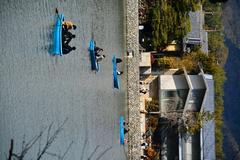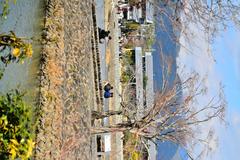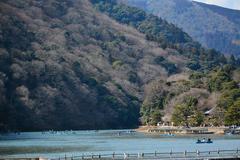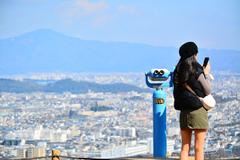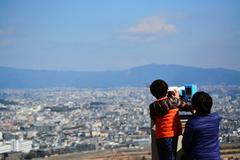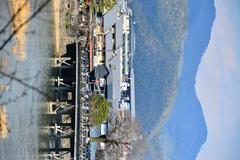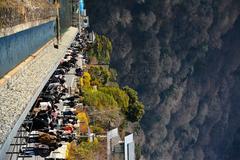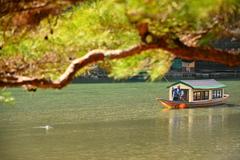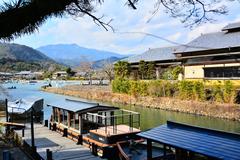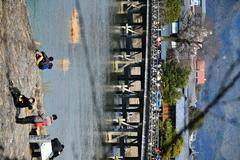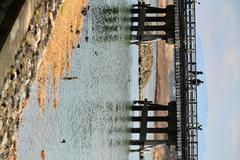
Arashiyama Kyoto: Visiting Hours, Tickets, and Travel Guide
Date: 14/06/2025
Introduction
Arashiyama, situated on the western edge of Kyoto, is one of Japan’s most celebrated districts, renowned for its breathtaking natural scenery, rich cultural heritage, and historical landmarks. Famed for the iconic Arashiyama Bamboo Grove, this area offers a harmonious blend of tranquil landscapes, spiritual sites, and seasonal festivities, making it a must-visit for travelers seeking an authentic Kyoto experience. This detailed guide provides everything you need to know about Arashiyama’s history, cultural significance, practical visitor information, transportation, and insider tips to ensure a memorable and seamless visit (article.bespes-jt.com).
Table of Contents
- Introduction
- Historical Evolution of Arashiyama
- Practical Visitor Information
- Cultural Significance and Symbolism
- Key Historical Figures and Sites
- Preservation and Modern Relevance
- Frequently Asked Questions (FAQ)
- Conclusion
- Sources
Historical Evolution of Arashiyama
Heian Period Origins
Arashiyama’s historical roots extend back to the Heian period (794–1185), when it served as an exclusive retreat for the Kyoto aristocracy. Emperor Saga established a detached imperial villa in the area, fostering a vibrant atmosphere of poetry, art, and seasonal festivities. The name “Arashiyama” (“Storm Mountain”) was inspired by the dramatic swirling of autumn leaves, a phenomenon celebrated in classical Japanese literature. Seasonal appreciation, especially cherry blossom viewing (hanami) and autumn leaf hunting (momijigari), became integral traditions (article.bespes-jt.com, sakuratrips.com).
Medieval and Early Modern Era
The Kamakura and Muromachi periods saw the construction of prominent temples, notably Tenryu-ji Temple, founded in 1339 by Ashikaga Takauji to honor Emperor Go-Daigo. Designed by Zen master Muso Soseki, Tenryu-ji’s gardens ingeniously incorporate the surrounding landscape, exemplifying the concept of shakkei, or “borrowed scenery” (touristinjapan.com, travelinculture.com). Despite repeated destruction by fire and war, these temples were resiliently rebuilt, underscoring Arashiyama’s enduring spiritual significance.
During the Edo period, bamboo cultivation flourished, becoming both an aesthetic hallmark and a resource for crafts and cuisine. The tradition of seasonal leisure outings became deeply embedded in local culture (insidekyoto.com).
Modern Preservation and Tourism
To safeguard its unique environment, the government enacted preservation measures in 1967, particularly to protect the bamboo groves from urban encroachment. Today, Arashiyama is recognized as a premier scenic district, attracting millions annually. The iconic Togetsukyo Bridge, originally dating to the Heian period and rebuilt in the 1930s, remains a central viewing spot for cherry blossoms and autumn foliage (article.bespes-jt.com).
Practical Visitor Information
Visiting Hours and Ticketing
- Arashiyama Bamboo Grove: Open 24 hours, year-round, with free access. Early morning (before 9:00 AM) is recommended for a peaceful experience (Japan Suki).
- Tenryu-ji Temple: Open daily from 8:30 AM to 5:30 PM (last admission 5:00 PM). Admission: approx. 500 yen for adults (official site).
- Okochi Sanso Villa: Open 9:00 AM to 5:00 PM. Admission: 1,000 yen (includes matcha tea and sweet) (okochi-sanso.com).
- Togetsukyo Bridge: Always open; no admission fee.
- Nonomiya-jinja Shrine: Open 6:00 AM to 5:00 PM; free entry.
Some attractions, such as the Sagano Scenic Railway and Monkey Park Iwatayama, have separate ticketing and hours.
Getting There and Accessibility
- By JR Train: Take the JR Sagano Line from Kyoto Station to Saga-Arashiyama Station (15–20 minutes), then a 10-minute walk to the bamboo grove.
- By Hankyu Line: Hankyu Arashiyama Station is about a 15-minute walk to the main sights.
- By Randen Tram: The Keifuku Randen Line Arashiyama Station is close to the bamboo grove.
- By Bus: Several Kyoto city buses serve the area but may be slow during peak times (Japan Experience, VacayWork).
Accessibility: Main paths are generally flat and suitable for wheelchairs, but some temple grounds and slopes may be challenging. Public toilets and lockers are available at Saga-Arashiyama Station (Kyoto Travel).
Guided Tours and Experiences
Enhance your visit with:
- Guided walking tours
- Tea ceremonies
- Kimono rentals
- Culinary experiences featuring local specialties such as yudofu and bamboo shoot dishes (sakuratrips.com, Ninja Food Tours)
Nearby Attractions and Photo Spots
- Sagano Scenic Railway: 25-minute scenic train ride along the Hozu River; tickets ~620 yen (Rove.me).
- Monkey Park Iwatayama: 9:00 AM–4:00 PM; admission 550 yen; 30-minute hike for panoramic Kyoto views.
- Kameyama Park: Free, with walking trails and river views.
- Other Notable Temples: Jojakko-ji, Nison-in, and Hogonin offer tranquil gardens and seasonal foliage.
Seasonal Events and Festivals
- Momiji Festival (Autumn): Traditional music and dance celebrate fall foliage (umetravel.com).
- Hanatouro (December): Bamboo Grove and streets illuminated with lanterns (traditionalkyoto.com).
- Cormorant Fishing (Summer): Demonstrations on the Hozu River.
- Kifune Festival and Bugaku Dance: Held in June, featuring ancient court dances (Magical Trip).
Cultural Significance and Symbolism
Nature and Spirituality
Arashiyama epitomizes the Japanese ideal of harmony between nature and human artistry. The district’s lush setting, marked by the Katsura River, mountains, and bamboo groves, has long inspired poets and artists. The bamboo grove symbolizes resilience and tranquility, while temples like Tenryu-ji and shrines such as Nonomiya-jinja offer spaces for spiritual contemplation (visitinsidejapan.com, insidekyoto.com).
Artistic and Literary Heritage
The Heian aristocrats’ tradition of waka poetry, seasonal festivals, and the district’s depiction in ukiyo-e woodblock prints have cemented Arashiyama’s place in Japanese cultural history. Modern events, such as the Momiji Festival and Hanatouro illumination, continue to celebrate this artistic heritage (sakuratrips.com, umetravel.com).
Key Historical Figures and Sites
- Emperor Saga: Established Arashiyama as an imperial retreat (article.bespes-jt.com).
- Ashikaga Takauji: Founded Tenryu-ji Temple (touristinjapan.com).
- Muso Soseki: Designed Tenryu-ji’s celebrated Zen gardens (travelinculture.com).
Iconic Sites:
- Togetsukyo Bridge: “Moon Crossing Bridge,” a symbol of Arashiyama (article.bespes-jt.com).
- Tenryu-ji Temple: UNESCO World Heritage site (visitinsidejapan.com).
- Arashiyama Bamboo Grove: A living testament to bamboo’s cultural role (insidekyoto.com).
- Nonomiya-jinja Shrine: Noted for purification rituals and literary connections (insidekyoto.com).
Preservation and Modern Relevance
Conservation Efforts
The protection of Arashiyama’s bamboo groves and historic sites has ensured their survival for future generations. Many are now UNESCO World Heritage or National Historic Sites (japan-travel-note.com).
Contemporary Role
Arashiyama remains a vibrant symbol of Japanese identity, drawing both domestic and international visitors. Its accessibility and array of traditional experiences, from tea ceremonies to kimono rentals, make it a vital part of Kyoto’s tourism landscape (sakuratrips.com, traditionalkyoto.com).
Frequently Asked Questions (FAQ)
Q: What are the Arashiyama Bamboo Grove visiting hours?
A: The grove is open 24/7, year-round, with free entry.
Q: Do I need tickets for the Bamboo Grove or Tenryu-ji Temple?
A: No ticket is required for the Bamboo Grove. Tenryu-ji Temple admission is around 500 yen.
Q: How do I get to Arashiyama from Kyoto Station?
A: Take the JR Sagano Line to Saga-Arashiyama Station (15–20 min), then walk 10 minutes.
Q: Is the area accessible for wheelchairs?
A: Main paths are generally accessible, but some temple grounds may require assistance.
Q: When is the best time to visit?
A: Early mornings in spring (cherry blossoms) and autumn (foliage) offer the most scenic and peaceful experiences.
Conclusion
Arashiyama is a timeless destination blending natural wonders, spiritual sites, and deep-rooted cultural traditions. With year-round attractions, vibrant festivals, and easy accessibility, it is an essential stop for any visitor to Kyoto. Use this guide to plan your journey, explore both famous and hidden gems, and immerse yourself in one of Japan’s most treasured landscapes.
For the latest updates, detailed maps, and personalized itineraries, download the Audiala app and follow us on social media. Begin your journey into the heart of Kyoto’s history and beauty—Arashiyama awaits.
Sources
- Arashiyama: Visiting Hours, Tickets, and Guide to Kyoto’s Historical Sites, 2025, Bespes JT
- Ultimate Guide to Arashiyama Bamboo Grove: Visiting Hours, Tickets, and Kyoto Historical Sites, 2025, Sakuratrips
- Arashiyama Bamboo Grove Visiting Hours, Tickets, and Seasonal Highlights in Kyoto, 2025, You Could Travel
- Practical Visitor Tips for Arashiyama: Visiting Hours, Tickets, and Exploring Kyoto Historical Sites, 2025, Japan Travel Explorer
- Tenryu-ji Temple, 2025, Tourist in Japan
- Arashiyama Bamboo Grove Guide, 2025, Inside Kyoto
- Arashiyama Momiji Festival, 2025, Ume Travel
- Arashiyama District and Hanatouro Illumination, 2025, Traditional Kyoto
- Top 10 Popular Kyoto Cultural Heritage Sites, 2025, Visit Inside Japan

